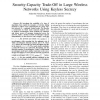Free Online Productivity Tools
i2Speak
i2Symbol
i2OCR
iTex2Img
iWeb2Print
iWeb2Shot
i2Type
iPdf2Split
iPdf2Merge
i2Bopomofo
i2Arabic
i2Style
i2Image
i2PDF
iLatex2Rtf
Sci2ools
MOBIHOC
2010
ACM
2010
ACM
Security-capacity trade-off in large wireless networks using keyless secrecy
We investigate the scalability of a class of algorithms that exploit the dynamics of wireless fading channels to achieve secret communication in a large wireless network of n randomly located nodes. We describe a construction in which nodes transmit artificial noise to suppress eavesdroppers whose locations are unknown and ensure secrecy of messages transported across the network. Under a model in which eavesdroppers operate independently, we show that for some constant c such that 0 < c < 1, the network can tolerate ,," 1 n (n) "2c
Achievable Per-node Throughput | Computer Networks | Large Wireless Network | MOBIHOC 2010 | Throughput |
| Added | 14 Feb 2011 |
| Updated | 14 Feb 2011 |
| Type | Journal |
| Year | 2010 |
| Where | MOBIHOC |
| Authors | Sudarshan Vasudevan, Dennis Goeckel, Donald F. Towsley |
Comments (0)

